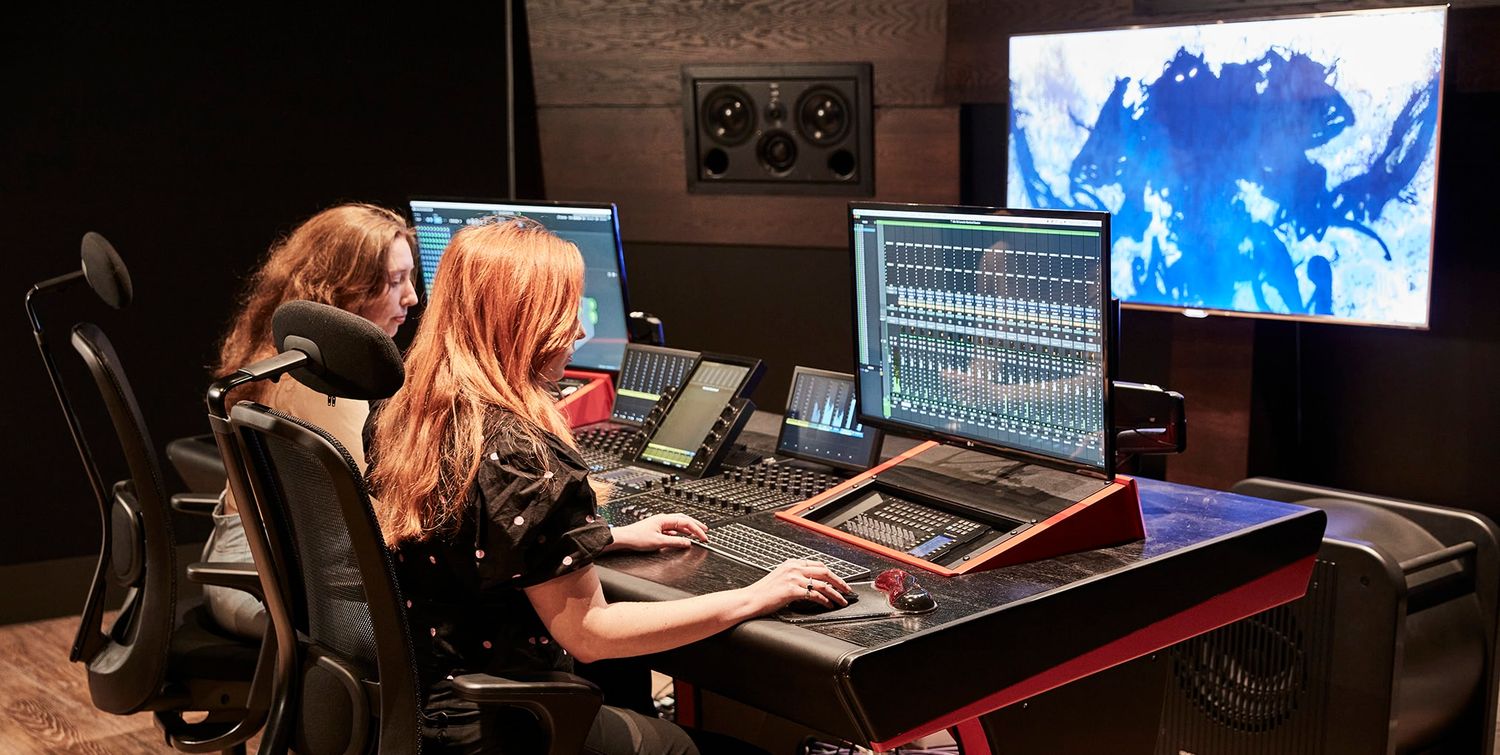Home>Production & Technology>Background Music>Why Does Background Music Come And Go In Movie


Background Music
Why Does Background Music Come And Go In Movie
Modified: January 22, 2024
Find out why background music in movies sometimes fades in and out, and how it contributes to the overall cinematic experience. Discover the significance of background music in enhancing emotions and creating atmosphere.
(Many of the links in this article redirect to a specific reviewed product. Your purchase of these products through affiliate links helps to generate commission for AudioLover.com, at no extra cost. Learn more)
Table of Contents
- Introduction
- The Role of Background Music in Movies
- Factors Influencing the Presence of Background Music
- Importance of Silence and Absence of Background Music
- Psychological Impact of Background Music in Movies
- Techniques Used to Manipulate Background Music in Movies
- Common Reasons for Background Music Changing or Disappearing in Movies
- Impact of Background Music Changes on Audience Perception
- Conclusion
Introduction
Background music plays a crucial role in enhancing the cinematic experience for viewers. It sets the tone, creates emotions, and drives the narrative forward in movies. Whether it’s a thrilling chase scene, a romantic moment, or a suspenseful buildup, the right background music can intensify the impact of the visuals and dialogue on screen.
However, it is not uncommon for background music to come and go in movies. This temporary absence or change in music can catch the audience off guard and significantly affect their perception of the film. In this article, we will explore the reasons why background music in movies fluctuates, and the impact it has on the overall viewing experience.
Throughout the article, we will delve into the different techniques used by filmmakers to manipulate background music and the various factors that contribute to its presence or absence. Additionally, we will discuss the psychological impact of background music on viewers and how these fluctuations can influence their emotional response to the film.
Furthermore, we will explore the significance of silence and the intentional absence of background music in certain scenes. Sometimes, the absence of music at a critical moment can create a sense of tension or increase the impact of the visuals and dialogue on screen.
Understanding why background music in movies changes or disappears is essential for filmmakers and enthusiasts alike. By gaining insight into the factors influencing these fluctuations, we can appreciate the art of cinematography and music composition even more.
So, join us as we embark on a journey into the world of background music in movies and explore the fascinating reasons behind its ever-changing presence.
The Role of Background Music in Movies
Background music serves as a powerful tool in enhancing the cinematic experience for viewers. It plays a pivotal role in evoking emotions, setting the mood, and guiding the audience’s emotional response to what they see on screen.
One of the primary functions of background music is to intensify the impact of certain scenes. It can heighten suspense during thrilling action sequences, create a sense of romance during intimate moments, or evoke fear during horror scenes. The right music at the right time can amplify the emotions that the filmmakers want the audience to feel, enriching the overall viewing experience.
Background music also helps in establishing the setting and time period of a film. Through the use of specific musical genres or styles, filmmakers can transport the audience to a different era or culture, enhancing the authenticity and immersion of the story. For example, a period drama set in the 1920s might feature jazz music, while a sci-fi film set in the future might utilize electronic or orchestral compositions to create a futuristic atmosphere.
In addition to enhancing emotional impact and establishing setting, background music also aids in pacing and transitions within a movie. It can smooth out scene changes, create seamless transitions between different locations or time periods, and maintain the overall flow of the narrative. The right musical cues can effectively guide the audience through the story, ensuring that they remain engaged and connected to the film.
Moreover, background music serves as a crucial storytelling device. It can foreshadow events or reveal hidden emotions of characters. By using motifs or recurring musical themes, filmmakers can create narrative consistency, linking specific moments or characters throughout the film. This creates a sense of cohesion and deeper connection for the audience, enhancing their understanding and enjoyment of the story.
Overall, background music plays an integral role in movies, enhancing emotions, setting the tone, guiding the audience’s response, and adding depth to the storytelling. Its presence and strategic placement are essential in creating a memorable cinematic experience that resonates with viewers long after the credits roll.
Factors Influencing the Presence of Background Music
The presence of background music in movies is influenced by various factors, including artistic choices, storytelling requirements, and technical considerations. Here are some key factors that impact the decision to include or exclude background music in a film:
- Genre and Mood: The genre and overall mood of the movie play a significant role in determining the presence of background music. For instance, action-packed films often feature intense and dramatic music to heighten the excitement, while romantic movies may rely on gentle and melodic compositions to evoke emotions. The genre and mood dictate the type of music that suits the scene and the desired impact on the audience.
- Story Emphasis: The story itself determines when and how background music is integrated into a film. Filmmakers strategically choose moments to highlight or downplay certain scenes. They may introduce music to emphasize important plot developments, character revelations, or pivotal emotional moments. Conversely, they may opt for silence or minimal music to allow the dialogue or visuals to take center stage.
- Director’s Vision: The director’s vision and personal style greatly influence the use of background music. Some directors prefer a minimalist approach, using music sparingly to create powerful impact during specific moments. Others embrace a more continuous musical presence, seamlessly blending compositions throughout the film. The director’s artistic vision is key in determining how music is used to enhance the overall cinematic experience.
- Sound Design and Mixing: The technical aspects of sound design and mixing also contribute to the presence of background music. Sound engineers and composers work together to ensure that the music integrates seamlessly with other audio elements, such as dialogue, sound effects, and ambient noise. They consider factors like volume, spatial placement, and frequency range to create a balanced and immersive auditory experience.
- Budget Constraints: Budget limitations can impact the inclusion of background music in movies. Licensing popular songs or hiring composers to create original scores can be costly. Filmmakers may need to carefully allocate their resources and make strategic decisions regarding when and where to use music in order to stay within budget constraints.
These factors, among others, contribute to the decision-making process behind the presence or absence of background music in movies. Filmmakers carefully consider the artistic, narrative, and technical requirements of each scene to create a cohesive and impactful cinematic experience that resonates with the audience.
Importance of Silence and Absence of Background Music
While background music is a powerful tool in enhancing the cinematic experience, the intentional use of silence and absence of background music can have a profound impact on the audience. Silence, in itself, holds immense power to create tension, emphasize key moments, and evoke emotions that words or music alone cannot achieve.
One of the primary reasons for the deliberate absence of background music is to create a sense of realism and authenticity in a movie. By removing music from certain scenes, filmmakers can mimic real-life situations where there is no continuous soundtrack accompanying our everyday lives. This allows the audience to connect more deeply with the characters and the story, as they experience a more raw and unfiltered representation of the events unfolding on screen.
The absence of background music also serves as a tool to enhance specific moments of high emotional impact. By removing music during pivotal scenes, filmmakers create a void that amplifies the intensity of the moment. Whether it’s a dramatic revelation, a shocking twist, or a heartbreaking climax, the absence of music draws the audience’s focus solely on the visuals and dialogue, intensifying the emotional impact and creating a lasting impression.
Silence can also be used to create suspense and tension. By removing any background music, filmmakers leave a void that creates an atmosphere of uncertainty and anticipation. The absence of music allows for subtle ambient sounds, such as footsteps or the sound of a ticking clock, to become more pronounced, heightening the feeling of suspense and keeping the audience on the edge of their seats.
Moreover, silence can be an effective tool to provide relief and respite within a film. After a thrilling action sequence or a highly emotional scene, a moment of silence allows both the characters and the audience to process what has just transpired. It creates a pause, giving the viewers a chance to breathe, reflect, and prepare for what comes next.
The intentional use of silence and absence of background music demonstrates the mastery of filmmakers in utilizing all elements of audio and visual storytelling. By strategically incorporating moments of silence, they create a dynamic and balanced cinematic experience that fully engages the audience’s senses and emotions.
So, while background music undoubtedly plays a crucial role in movies, the intentional absence of such music in certain scenes can be just as impactful, allowing for moments of realism, emotional intensification, suspense, and relief. It is this careful balance between music and silence that enhances the overall viewing experience and showcases the artistry of filmmaking.
Psychological Impact of Background Music in Movies
Background music in movies has a profound psychological impact on viewers, influencing their emotions, perceptions, and overall engagement with the film. Music is a universal language that can evoke powerful emotional responses and create a deeper connection between the audience and the story being told.
One of the primary psychological impacts of background music is its ability to elicit and intensify emotions. The combination of visuals and music can enhance the audience’s emotional experience, whether it’s feeling joy, sadness, fear, or excitement. By selecting the right musical cues and compositions, filmmakers can manipulate the viewer’s emotions, amplifying the impact of the narrative and creating a more immersive cinematic experience.
Background music also has the power to influence the viewer’s perception of time. It can create a sense of urgency, making time appear to move faster during thrilling action sequences, or slow it down during poignant moments. This manipulation of time perception heightens the viewer’s sense of suspense or emotional engagement, keeping them captivated and invested in the story unfolding on screen.
Moreover, background music can create a sense of familiarity or recognition for the audience. Certain musical motifs or themes can become iconic and instantly associated with a specific character, film franchise, or genre. The mere presence of familiar music can evoke nostalgia, triggering memories and emotions from previous experiences, and deepening the audience’s connection to the story and characters.
In addition, background music plays a crucial role in attention and focus. It acts as a guiding force, directing the viewer’s attention to specific elements on screen. By synchronizing the music with key moments or visual cues, filmmakers can enhance the audience’s focus and ensure that important story elements are not missed. This attentional guidance keeps viewers engaged and immersed in the film, enhancing their overall experience.
Furthermore, background music can serve as a form of nonverbal communication, conveying information, and enhancing the storytelling. It can signify transitions between scenes, indicate changes in mood or atmosphere, or provide insight into characters’ thoughts and feelings. This nonverbal communication through music adds depth and complexity to the narrative, allowing for a multi-dimensional viewing experience.
Overall, the psychological impact of background music in movies is undeniable. From influencing emotions and perception of time to creating familiarity, guiding attention, and enhancing storytelling, music plays a key role in shaping the viewer’s psychological and emotional engagement with the film. It is through this powerful combination of visuals and music that filmmakers can create an immersive and impactful cinematic experience for their audience.
Techniques Used to Manipulate Background Music in Movies
Manipulating background music in movies involves a range of techniques that filmmakers utilize to enhance the storytelling, evoke emotions, and create a dynamic cinematic experience. Here are some common techniques used to manipulate background music:
- Music Swells and Diminishes: Filmmakers often use crescendos and diminuendos to increase or decrease the volume and intensity of the background music. This technique allows them to control the emotional impact of a scene, building tension or creating a sense of release at strategic moments.
- Musical Cues and Leitmotifs: Certain musical cues or leitmotifs are associated with specific characters, locations, or themes in a movie. Filmmakers strategically use these recurring musical motifs to establish connections and evoke emotional responses from the audience, deepening their engagement with the story.
- Stingers and Tense Moments: Stingers refer to short, sharp bursts of music that are used to emphasize sudden shocks or surprise moments in a film. These stingers create a jarring effect and heighten the audience’s reaction to unexpected events, intensifying the overall suspense or horror of a scene.
- Tempo and Rhythm Alterations: Changing the tempo or rhythm of background music can significantly impact the mood and energy of a scene. Slowing down the tempo can create a sense of melancholy or add weight to dramatic moments, while increasing the tempo can heighten excitement or intensify an action sequence.
- Contrast and Juxtaposition: Playing contrasting songs or genres against the visuals on screen can create intriguing juxtapositions and add depth to a scene. This technique can be used to evoke irony, highlight character traits, or create a specific tone or atmosphere.
- Emotional Resonance: Background music can be chosen to resonate emotionally with the audience, eliciting a specific emotional response. For instance, using sentimental or nostalgic music during a flashback sequence can evoke a sense of longing or nostalgia in the viewers, intensifying the emotional impact of the scene.
- Silence and Absence: Intentional use of silence or absence of background music can create a dramatic effect and amplify certain scenes. The absence of music can draw attention to the dialogue, sound effects, or ambient sounds, intensifying the emotional impact and creating a sense of realism.
- Dynamic Layering: Using multiple layers of music simultaneously can create complexity and depth in a scene. By blending different instruments, melodies, or rhythms, filmmakers can build a rich sonic landscape that enhances the visuals and storytelling, adding texture to the overall cinematic experience.
These techniques, among others, allow filmmakers to manipulate background music in movies, enhancing the narrative, evoking emotions, and creating a dynamic and immersive cinematic experience. The careful and intentional use of these techniques is crucial in crafting a compelling and memorable film that resonates with the audience.
Common Reasons for Background Music Changing or Disappearing in Movies
Background music in movies can change or disappear for various reasons, each serving a specific purpose in enhancing the storytelling and overall cinematic experience. Here are some common reasons for these fluctuations:
- Emphasis on Dialogue: In certain scenes, filmmakers may choose to reduce or eliminate background music to prioritize the dialogue. This allows the audience to focus on the conversations and ensures that important information or character interactions are not overshadowed by the music.
- Creating Tension: Filmmakers often deliberately remove background music to create suspense and tension in specific scenes. Silence or minimal sound design can heighten the sense of anticipation, making the audience more alert and engaged with the unfolding events. This technique is particularly effective in horror or thriller genres.
- Ambient Sound or Sound Effects: At times, filmmakers may choose to let natural or environmental sounds take precedence over background music. This can create a sense of realism and immerse the audience in the world of the film. By focusing on ambient sound or enhancing specific sound effects, filmmakers can enhance the sensory experience and add depth to the storytelling.
- Symbolic Silence: The intentional absence of background music can be used symbolically to represent a significant moment or emotional state of a character. By removing music during a pivotal scene, filmmakers emphasize the gravity or impact of the moment, allowing the visuals and performances to speak for themselves.
- Contrast or Irony: Changing or removing background music can be done to create contrast or irony in a scene. For example, a sudden shift from intense music to silence or a contrasting genre of music can create an unexpected and powerful effect, emphasizing an ironic twist or subverting audience expectations.
- Transitioning Between Scenes: Background music often changes or fades during scene transitions to indicate a shift in time, location, or mood. This helps to smoothly guide the viewers from one scene to the next and maintain the flow of the narrative.
- Performance Showcasing: In certain films, like musicals or dance sequences, background music may disappear or reduce in volume during moments that showcase live performances. This allows the viewers to fully appreciate and immerse themselves in the live performance, highlighting the talent and skill of the performers.
These are just a few of the many reasons why background music in movies may change or disappear. These fluctuations are carefully planned and executed by filmmakers to enhance the storytelling, create emotional impact, build tension, and maintain the flow and engagement of the audience throughout the film.
Impact of Background Music Changes on Audience Perception
The changes in background music in movies have a significant impact on the audience’s perception and overall viewing experience. These fluctuations are carefully orchestrated to guide emotions, amplify tension, and shape the narrative. Here are some key ways in which background music changes impact audience perception:
Emotional Engagement: Altering the background music can elicit a range of emotional responses in the audience. Intensifying or changing the music during an emotionally charged scene can heighten the impact and make the viewers feel more connected to the characters and the story. Conversely, stripping away music during a tender or poignant moment can create a sense of vulnerability and evoke a deeper emotional response.
Surprise and Suspense: Sudden changes in background music can generate surprise and suspense in the audience. By manipulating the music, filmmakers can create unexpected shifts in mood or tone, keeping the viewers on their toes. These changes can heighten the suspense during a thrilling chase or add shock value to a plot twist, resulting in a more engaging and memorable viewing experience.
Character Development: Background music changes can be employed to reflect the growth or transformation of a character. The shifting music can signify a change in their internal state, altering the audience’s perception of the character’s journey. A shift from somber to empowering music, for example, can mark a turning point in a character’s arc, evoking feelings of strength and empowerment in the audience.
Perception of Time: Background music changes can also influence the audience’s perception of time within the film. Altering the music tempo or intensity can make a scene appear shorter or longer, affecting the pacing of the narrative. This perception of time can evoke different emotions and create narrative tension, ensuring that the audience remains engaged and invested in the story.
Symbolism and Foreshadowing: Background music changes can also be used as a form of symbolism or foreshadowing. By shifting the music’s mood or incorporating leitmotifs, filmmakers can subtly hint at future events, create narrative connections, or convey hidden meanings. The audience may not fully understand the significance of the music changes in the moment but may later recognize their importance, adding depth and complexity to their perception of the film.
Ultimately, the changes in background music have a profound impact on the audience’s perception, engagement, and emotional experience. They shape the narrative, amplify emotions, and create a dynamic atmosphere that captivates the viewers. The carefully crafted manipulation of background music is an integral part of the filmmakers’ toolkit, allowing them to craft a more immersive and impactful cinematic experience for the audience.
Conclusion
Background music in movies serves as a powerful tool in enhancing the cinematic experience for viewers. Its strategic placement and manipulation can evoke emotions, set the mood, and guide the audience’s emotional response to the story being portrayed on screen. Whether it’s intensifying suspense, creating a sense of romance, or emphasizing key moments, background music plays a pivotal role in conveying the filmmaker’s artistic vision and engaging the audience on a deeper level.
Throughout this article, we have explored the various aspects of background music in movies, including its role in enhancing the storytelling, the factors influencing its presence, and the psychological impact it has on viewers. We have also examined the techniques used by filmmakers to manipulate background music, as well as the common reasons for its changes or disappearance within a film. Each of these elements, when carefully orchestrated, contributes to a more immersive and memorable cinematic experience.
From the importance of silence and the deliberate absence of background music to the impact of music changes on audience perception, we have discovered how these fluctuations can intensify emotions, create suspense, and shape the viewer’s engagement with the film. It is through the careful balance of background music, silence, and strategic changes that filmmakers weave a rich tapestry of audio and visual storytelling, captivating the audience and leaving a lasting impression.
In conclusion, background music is an integral part of the movie-watching experience. Its presence, timing, and manipulation significantly impact the audience’s emotional connection with the narrative, their perception of time, and their overall engagement. Understanding the role and impact of background music in movies allows us to appreciate the intricate artistry behind the creation of a truly captivating and immersive cinematic experience.











